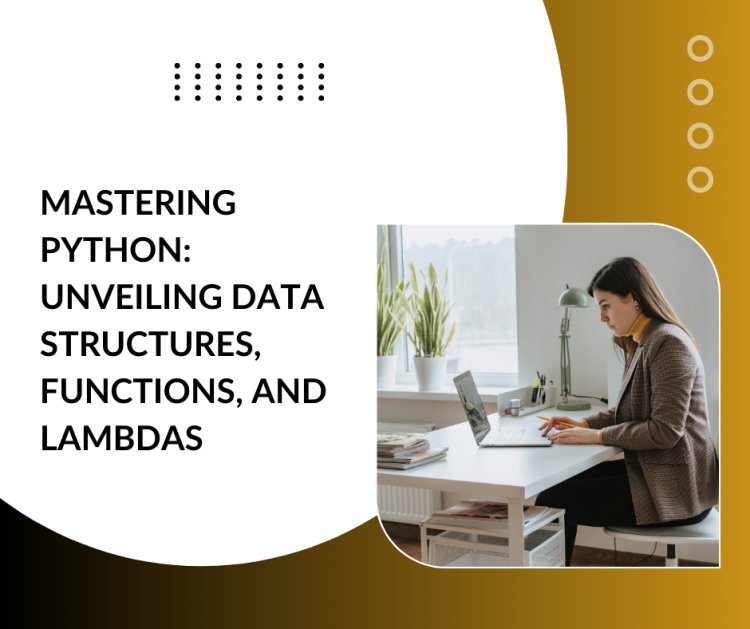Mastering Python: Unveiling Data Structures, Functions, and Lambdas
Share this Post to earn Money ( Upto ₹100 per 1000 Views )

Python, renowned for its simplicity and versatility, empowers developers to tackle a myriad of programming challenges with ease. Exploring advanced Python programming involves mastering the intricate interplay between data structures, functions, and lambdas. In this comprehensive guide, we embark on a journey to unravel these fundamental concepts, equipping you with the knowledge and skills to wield Python's power effectively.
Understanding Data Structures:
At the core of Python programming lie a plethora of data structures, each tailored to specific tasks and scenarios. Understanding these structures is crucial for efficient data manipulation and algorithm design.
-
Lists: Denoted by square brackets, lists serve as mutable sequences capable of storing heterogeneous elements. The dynamic nature of lists facilitates operations like appending, extending, inserting, and slicing, making them indispensable for various applications.
-
Tuples: Enclosed in parentheses, tuples represent immutable sequences ideal for storing fixed collections of values. While lacking the mutability of lists, tuples offer enhanced performance and integrity, making them suitable for scenarios where data immutability is desired.
-
Dictionaries: Represented by curly braces, dictionaries enable efficient key-value pair mappings. Leveraging unique keys, dictionaries provide fast retrieval of values, supporting operations like insertion, deletion, and lookup with near-constant time complexity.
-
Sets: Denoted by curly braces without key-value pairs, sets offer an unordered collection of unique elements. Set operations like union, intersection, difference, and symmetric difference facilitate set manipulation and comparison, enabling efficient data processing.
-
Arrays: Available through the 'array' module, arrays provide compact storage of homogeneous data types, enhancing memory efficiency and performance. Utilizing arrays for numerical computations and memory-constrained environments yields significant benefits in terms of speed and resource utilization.
Understanding the characteristics, strengths, and weaknesses of each data structure empowers you to choose the most appropriate one for your specific programming needs, optimizing performance and resource utilization.
Exploring Functions:
Functions constitute the building blocks of Python programs, encapsulating reusable blocks of code and promoting modularity and code readability.
-
Function Definition: Defining functions begins with the 'def' keyword followed by the function name and parameters enclosed in parentheses. Leveraging default parameter values and variable-length argument lists enhances function flexibility and usability.
-
Scope: Understanding function scope, including local, global, and nonlocal scopes, is essential for proper variable access and preventing name clashes within nested functions. Adhering to scoping rules ensures code integrity and maintainability, minimizing potential errors and conflicts.
-
Recursion: Recursion, a powerful programming technique, involves functions calling themselves to solve problems iteratively. Understanding recursion principles and leveraging them judiciously enhances code elegance and algorithmic expressiveness, particularly in tasks amenable to recursive solutions like tree traversal and factorial calculation.
-
Decorators: Decorators, a high-level feature of Python, enable the modification or extension of the behavior of functions or methods without modifying their underlying code. By applying decorators, you enhance code reusability, maintainability, and extensibility, facilitating the implementation of cross-cutting concerns like logging, authentication, and caching.
Mastering Lambdas:
Lambda functions, also known as anonymous functions, offer a concise syntax for defining small, single-expression functions inline. While not suitable for complex logic or multi-line functions, lambdas excel in scenarios requiring brief, one-off functions.
-
Lambda Syntax: Lambda functions are defined using the 'lambda' keyword followed by parameters and an expression. The resulting lambda object can then be assigned to a variable or used directly in function calls or operations.
-
Functional Programming: Lambda functions are integral to functional programming paradigms like map, filter, and reduce. The map function applies a specified function to each element of an iterable, generating a new iterable of transformed values. Similarly, the filter function selectively retains elements from an iterable based on a specified condition, yielding a filtered iterable. While the reduce function is less prevalent in Python 3 due to the introduction of the 'functools' module, it aggregates elements of an iterable using a specified function to produce a single value.
-
Use Cases: Lambdas find application in scenarios requiring concise, one-line functions, such as sorting, filtering, and mapping operations. While not a replacement for named functions in all cases, lambdas offer a convenient shorthand for simple tasks where function definition overhead is unnecessary.
Conclusion:
Mastering advanced Python programming entails a deep understanding of data structures, functions, and lambdas, including those taught in a Python course in Lucknow, Gwalior, Delhi, Noida, and all locations in India. Armed with this knowledge, you can tackle complex programming challenges with confidence, leveraging Python's simplicity and versatility to craft elegant and efficient solutions.
By embracing Python's rich ecosystem of data structures, functions, and lambdas, you unlock the full potential of the language, empowering you to write clean, maintainable, and expressive code. Whether you're building web applications, data analytics pipelines, or machine learning models, proficiency in advanced Python programming is indispensable for realizing your programming ambitions. So dive deep, explore relentlessly, and elevate your Python prowess to new heights.








